You’ll find that neem oil destroys mosquitoes more effectively than synthetic pesticides because its active compound azadirachtin simultaneously attacks their hormonal systems, feeding behavior, and reproductive cycles while preventing the resistance development that plagues conventional treatments. Azadirachtin disrupts growth hormones, prevents larval molting, and inhibits egg-laying in females, achieving up to 98.1% larval reduction rates across major mosquito species including Aedes, Anopheles, and Culex. Understanding these mechanisms reveals why neem offers superior long-term mosquito control solutions.
How Azadirachtin Disrupts Mosquito Hormonal Systems
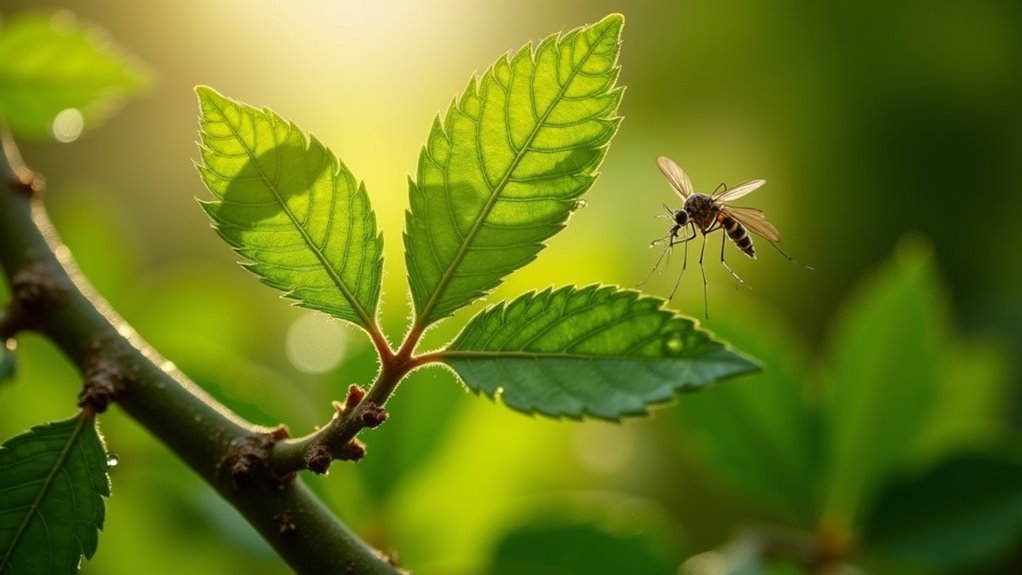
When mosquitoes encounter neem oil, azadirachtin—the compound’s primary active ingredient—launches a targeted attack on their hormonal systems.
This powerful anti-ecdysteroid disrupts the insects’ ability to produce essential growth hormones, effectively sabotaging their development cycle. You’ll find that azadirachtin prevents mosquito larvae from molting properly, trapping them between developmental stages where they can’t survive.
The compound doesn’t stop there—it also interferes with female mosquitoes’ reproductive capabilities by inhibiting oviposition, dramatically reducing their egg-laying capacity.
These combined larvicidal effects create a devastating one-two punch against mosquito populations. Research demonstrates that proper concentrations of azadirachtin achieve nearly complete larval mortality, making neem oil an exceptionally effective biological control agent that targets multiple life stages simultaneously.
Neem Oil’s Multi-Stage Attack on Mosquito Life Cycles
While most mosquito control methods target a single life stage, neem oil delivers a thorough assault across the entire mosquito development cycle. You’re getting multiple modes of action in one organic solution.
During the larval stage, azadirachtin demonstrates potent larvicidal activity with LC50 values of just 1.6-1.8 ppm across major species like Anopheles stephensi, Culex quinquefasciatus, and Aedes aegypti.
Azadirachtin delivers powerful larvicidal action at just 1.6-1.8 ppm concentrations, effectively targeting all major disease-carrying mosquito species.
This multi-stage attack continues into adulthood, where volatile compounds disrupt female gonotropic cycles, preventing egg-laying and breaking reproductive chains.
You’ll achieve enhanced results by combining neem seed cake with other treatments, creating effective integrated pest management strategies.
Field studies confirm this all-encompassing approach works, delivering 98.1% larval reduction rates and sustained population control across mosquito life cycles.
The Science Behind Neem’s Antifeedant Properties
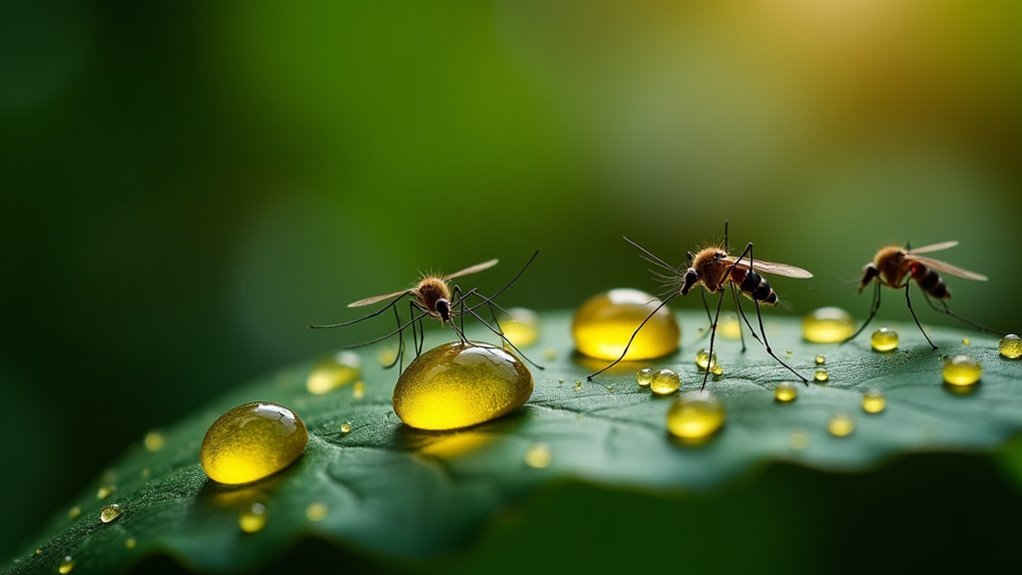
Beyond simply killing mosquitoes, neem oil’s azadirachtin compound fundamentally rewires their feeding behavior through sophisticated biochemical interference.
When you apply neem oil, azadirachtin acts as a powerful antifeedant that disrupts mosquito hormonal systems. This interference prevents female mosquitoes from obtaining essential nutrients needed for egg development by inhibiting their gonotropic cycles.
The compound doesn’t just stop feeding—it completely alters mosquito growth and development patterns. You’ll see dramatic population reductions as azadirachtin interferes with their reproductive capabilities.
This antifeedant mechanism works across all major mosquito species including Aedes, Anopheles, and Culex, making neem oil exceptionally versatile.
The biochemical disruption creates cascading effects that compromise their entire life cycle, delivering sustained mosquito control through natural biological warfare.
Why Mosquitoes Cannot Develop Resistance to Neem Oil
This natural disruption creates a fortress-like defense that mosquitoes simply can’t breach through evolutionary adaptation.
Unlike synthetic pesticides with single modes of action, neem oil delivers over 200 active compounds that attack mosquitoes simultaneously. You’re fundamentally deploying a multi-front assault that makes resistance development nearly impossible.
The primary compound azadirachtin functions as an insect growth regulatory agent, disrupting hormone systems while other phytochemicals target different biological processes.
This complex cocktail affects mosquitoes at larval, pupal, and adult stages, creating multiple pressure points they can’t overcome through genetic adaptation.
Your mosquito control strategy benefits from neem’s preservation of beneficial insects, maintaining natural predator populations.
This biological diversity reduces selective pressure on mosquito populations, further preventing resistance development that commonly occurs with conventional insecticides.
Neem Oil Safety Profile for Non-Target Species
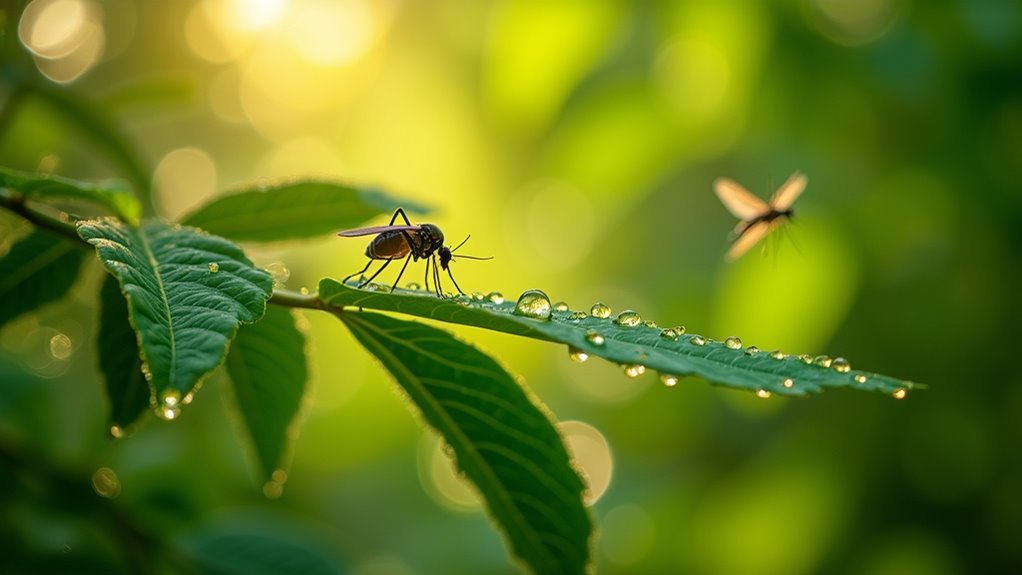
When you choose neem oil for mosquito control, you’re selecting a solution that protects beneficial wildlife while targeting pests. This natural insecticide demonstrates remarkably low toxicity to non-target organisms, making it a safe alternative to synthetic chemicals that harm birds, mammals, and aquatic life.
You’ll appreciate that neem oil’s active component, azadirachtin, preserves ecological balance by remaining non-toxic to beneficial insects like bees while effectively controlling mosquitoes.
The compound breaks down rapidly in soil and water, preventing long-term environmental contamination that threatens wildlife.
Research confirms you can use neem oil for pest control without worrying about harming fish or birds.
Unlike conventional insecticides, neem oil won’t accumulate in ecosystems, ensuring your mosquito control efforts support rather than disrupt natural biodiversity.
Environmental Breakdown and Biodegradability of Neem Compounds
When you apply neem oil for mosquito control, you’re using a naturally degrading compound that won’t persist in your environment like synthetic alternatives.
The oil’s active components break down through natural pathways in soil through microbial action, ensuring they don’t accumulate over time.
You’ll find that neem compounds also degrade safely in aquatic environments, protecting water systems while maintaining their pest control effectiveness.
Natural Degradation Pathways
Because neem oil’s active compounds break down naturally through multiple environmental pathways, you don’t need to worry about long-term chemical buildup when using it for mosquito control. The active ingredient azadirachtin degrades through several natural processes that make this mosquito repellent exceptionally eco-friendly.
| Environment | Degradation Timeline |
|---|---|
| Soil | 3-44 days half-life |
| Water | 48 minutes-4 days |
| Plant surfaces | 1-2.5 days residual |
| Air exposure | Rapid breakdown |
These natural degradation pathways guarantee neem oil maintains minimal environmental impact while effectively controlling mosquitoes. Unlike synthetic mosquito repellents that persist in ecosystems, neem compounds break down quickly through photodegradation, microbial activity, and hydrolysis. You’ll appreciate that this rapid breakdown protects beneficial insects while eliminating mosquito populations efficiently.
Soil Microbial Breakdown
Soil microorganisms play an essential role in breaking down neem oil’s active compounds, transforming azadirachtin and other phytochemicals into harmless byproducts through natural metabolic processes.
When you apply neem oil to your garden or yard, these beneficial bacteria and fungi immediately begin metabolizing the compounds, ensuring complete biodegradability within weeks.
This microbial breakdown considerably reduces neem’s ecological footprint compared to synthetic pesticides that persist for months or years.
You’ll find that soil organisms effectively eliminate azadirachtin residues, preventing accumulation that could harm beneficial insects or contaminate groundwater.
This natural degradation process makes neem oil an ideal choice for sustainable pest management, allowing you to control mosquitoes while maintaining healthy soil ecosystems.
Aquatic Environment Safety
While neem oil’s terrestrial breakdown demonstrates impressive environmental safety, its behavior in aquatic environments proves equally reassuring for water-conscious gardeners.
You’ll find that azadirachtin, the primary mosquito repellent compound, degrades remarkably fast in water—breaking down within 48 minutes to 4 days. This rapid biodegradability means your neem oil treatments won’t accumulate in ponds, streams, or other water sources.
The aquatic environments safety profile includes:
- Zero toxicity to birds and mammals drinking treated water
- Bee-friendly formula that won’t harm pollinators visiting water sources
- Minimal fish impact when applied responsibly near aquatic areas
You can confidently use neem oil knowing it targets mosquitoes effectively while maintaining ecological balance in sensitive water ecosystems.
Optimal Neem Oil Concentrations for Maximum Mosquito Control
You’ll find that determining the right neem oil concentration requires understanding the difference between controlled laboratory results and real-world field applications.
Laboratory studies show that formulations with 0.15% w/v azadirachtin achieve lethal concentrations as low as 1.6-1.8 ppm against major mosquito species like Anopheles stephensi and Aedes aegypti.
However, you’ll need higher field application rates of around 140 mg active ingredient per square meter to achieve the same 100% larval reduction in actual outdoor conditions.
Effective Concentration Ranges
Research consistently demonstrates that neem oil achieves maximum mosquito control at remarkably low concentrations, with lethal doses measured in parts per million rather than percentages.
You’ll find that effective concentrations for different mosquito species cluster around 1.6-1.8 ppm, proving neem’s potency against these disease vectors.
Your neem oil formulations containing just 0.15% azadirachtin deliver devastating larvicidal activity, achieving complete elimination of mosquito populations.
These concentration ranges work by disrupting the microorganisms’ development processes at critical life stages.
Consider these powerful concentration benefits:
- Ultra-low doses mean you’re using minimal product while achieving maximum impact
- Cost-effective control delivers 100% mortality rates without breaking your budget
- Long-lasting protection maintains effectiveness for weeks with single applications
These precise effective concentrations guarantee you’re maximizing neem’s mosquito-destroying potential.
Laboratory Versus Field
Laboratory testing provides the foundation for understanding neem oil’s mosquito-killing potential, but field applications reveal how these concentrations perform in real-world conditions.
You’ll find that laboratory studies pinpointed precise lethal concentrations between 1.6-1.8 ppm for Anopheles, Culex, and Aedes species. However, field trials using 140 mg a.i./m demonstrated even more impressive results than controlled laboratory settings suggested.
When you apply neem oil formulation in natural environments, you’ll achieve 95-98% larval reduction within one day across all three mosquito species.
What’s particularly encouraging is that this control maintains effectiveness for weeks, not just days. Your field applications will consistently outperform laboratory predictions, with Aedes larvae showing 100% control through day seven.
The formulation’s 18-month stability guarantees you’ll maintain ideal concentrations for sustained mosquito management in real-world conditions.
Comparing Neem Oil Effectiveness Across Different Mosquito Species
When you’re dealing with multiple mosquito species in your area, neem oil’s effectiveness remains remarkably consistent across different types. The larvicidal activity demonstrates impressive results with median lethal concentrations ranging from just 1.6 to 1.8 ppm across Anopheles, Culex, and Aedes species.
You’ll see devastating results within hours of application:
- Anopheles larvae face complete annihilation – 98.1% reduction on day one, escalating to 100% elimination within a week
- Culex populations crumble under sustained assault – 95.5% initial reduction with 80% effectiveness maintained over three brutal weeks
- Aedes mosquitoes suffer total defeat – 95.1% reduction at 24 hours, climbing to 99.7% by 48 hours
This consistent effectiveness across mosquito species means you won’t need different treatments for different problems.
Cost-Effective Production Methods for Neem-Based Mosquito Solutions
While neem oil’s proven effectiveness across mosquito species makes it an ideal natural solution, production costs often prevent widespread adoption for large-scale mosquito control programs.
You can achieve cost-effective neem oil formulation by optimizing traditional extraction processes used in Tamil Nadu. The cold pressing and solvent extraction process preserves essential bioactive compounds like azadirachtin while maintaining insecticidal properties.
You’ll find neem seed cake particularly valuable as an economical byproduct that provides mosquitocidal metabolites. When you mix it with other organic materials, you enhance its larvicidal activities considerably.
Large-scale neem cultivation in suitable climates reduces production costs dramatically. You can further lower expenses by researching optimized extraction methods and formulations, improving stability and efficacy while making neem-based mosquito control more accessible than synthetic alternatives.
Frequently Asked Questions
How Effective Is Neem Oil Against Mosquitoes?
You’ll find neem oil highly effective against mosquitoes, achieving 98.1% Anopheles larvae reduction and 95.5% Culex larvae reduction within one day. It’s proven lethal at 1.6-1.8 ppm concentrations while remaining stable.
What Is the Best Oil to Kill Mosquitoes?
You’ll find neem oil’s the most effective natural option, achieving 100% larval mortality with LC values under 2 ppm. Its azadirachtin compound disrupts mosquito cycles while remaining eco-friendly compared to synthetic alternatives.
Why Is Neem Oil Banned as a Pesticide?
Neem oil isn’t completely banned, but you’ll find it’s regulated in many places because it can harm fish and beneficial insects like bees, requiring you to follow strict safety guidelines.
How Fast Does Neem Oil Kill Mosquito Larvae?
You’ll see neem oil kill mosquito larvae incredibly fast. It achieves 100% mortality in first instar larvae and reduces populations by 98.1% within just the first day of application.
In Summary
You’ve seen how neem oil’s azadirachtin compound systematically dismantles mosquito biology at every level. You can’t go wrong with this natural solution that disrupts hormones, prevents feeding, and blocks reproduction while remaining safe for beneficial species. You’ll appreciate that mosquitoes can’t develop resistance to neem’s complex mechanisms. When you choose neem oil, you’re selecting an environmentally responsible, cost-effective approach that biodegrades naturally without harming ecosystems.

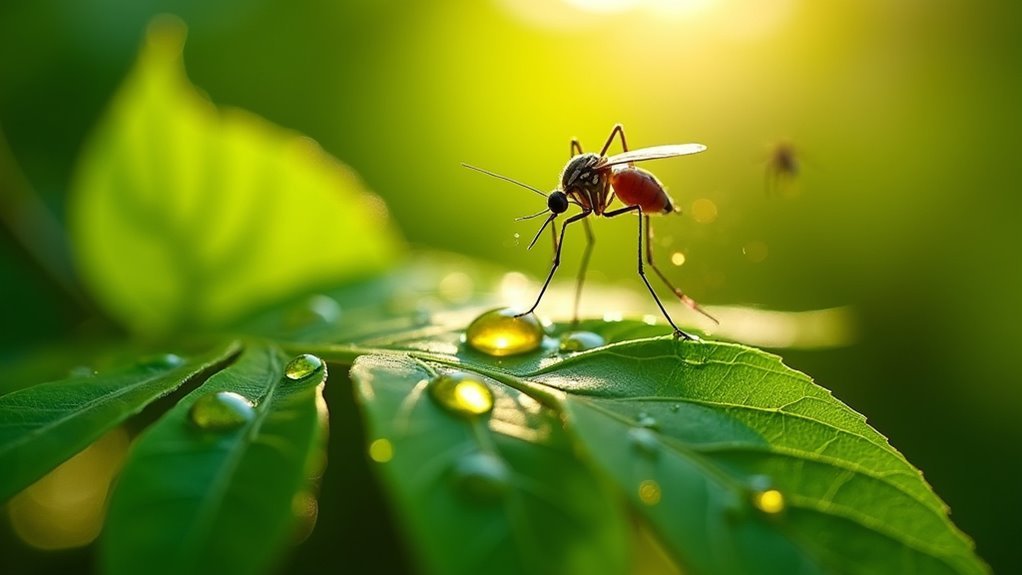


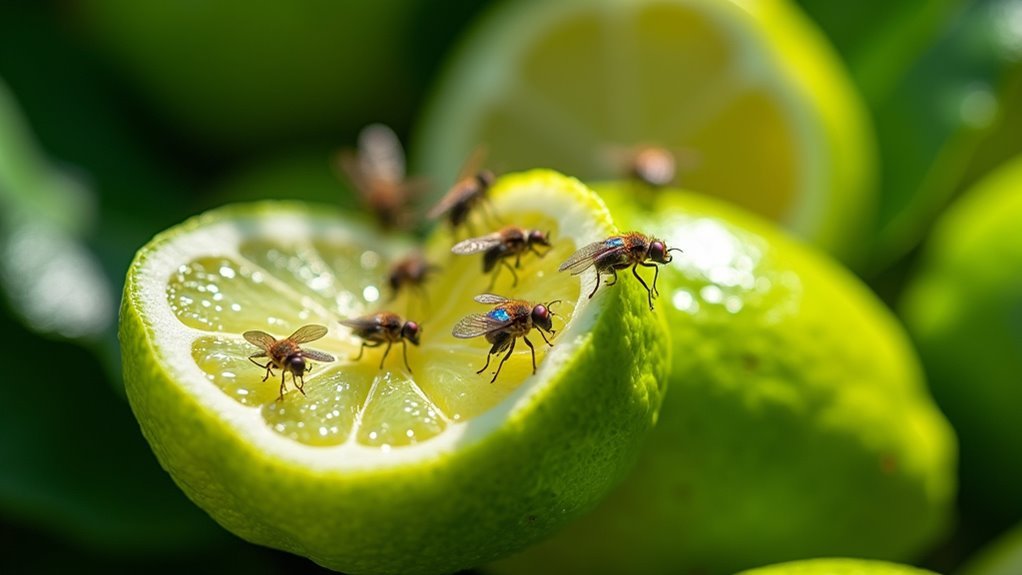
Leave a Reply